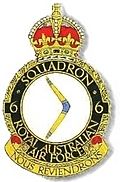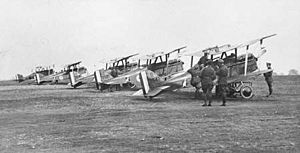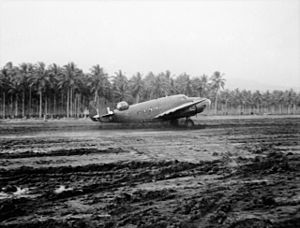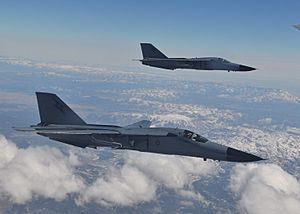No. 6 Squadron RAAF facts for kids
Quick facts for kids No. 6 Squadron RAAF |
|
|---|---|

No. 6 Squadron's crest
|
|
| Active | 1917–1919 1939–1945 1948–current |
| Country | Australia |
| Branch | Royal Australian Air Force |
| Role | Training (1917–1919) Bomber (1939–1945) Training (1948–2016) Electronic warfare (2017–current) |
| Part of | No. 82 Wing |
| Garrison/HQ | RAAF Base Amberley |
| Motto(s) | Nous Reviendrons (Latin: "We Shall Return") |
| Engagements | World War I World War II |
| Battle honours | Moresby 1942 New Britain 1943 |
| Commanders | |
| Notable commanders |
D. E. L. Wilson (1939–1940) Colin Hannah (1942–1943) Ray Funnell (1972–1975) Geoff Shepherd (1991–1993) |
| Aircraft flown | |
| Attack | F-4 Phantom II (1970–1972) F/A-18F Super Hornet (2011–2016) |
| Bomber | Hudson (1940–1943) Beaufort (1943–1945) Lincoln (1948–1955) Canberra (1955–1970) F-111 (1973–2010) |
| Electronic warfare |
EA-18G Growler (2017–current) |
| Patrol | Anson (1939–1940) |
| Reconnaissance | Learjet (1982–1987) |
No. 6 Squadron is a special unit in the Royal Australian Air Force (RAAF). They focus on electronic attack, which means they use technology to mess with enemy radar and communications.
It was first created in 1917 in England. Back then, during World War I, it was a training unit for pilots. The squadron closed down in 1919 but started up again in 1939.
During World War II, they flew light bomber planes and patrolled the seas. They fought in the New Guinea Campaign and New Britain Campaign. After the war, the squadron was closed again.
In 1948, No. 6 Squadron was started again. This time, their main job was to train pilots to fly bomber planes. They have mostly kept this training role. But they also had a secondary role to attack targets. From 1979 to 1993, they also flew reconnaissance (spy) missions.
Today, No. 6 Squadron is based at RAAF Base Amberley in Queensland. From 2011 to 2016, they flew Super Hornet aircraft. In 2017, the squadron switched to flying Boeing EA-18G Growler electronic attack planes.
Contents
History
World War I: Training Pilots
No. 6 Squadron was formed in England on 15 June 1917. It started as a flying training unit for the Australian Flying Corps (AFC). Its first name was No. 30 (Australian Training) Squadron.
The squadron's job was to train fighter pilots. These pilots would then join other AFC squadrons fighting on the Western Front.
The squadron moved several times in 1917. On 1 September, it became part of the 1st Training Wing. This wing controlled all four AFC training squadrons in England.
In January 1918, the squadron was renamed No. 6 Squadron AFC. It moved to Minchinhampton on 25 February. The squadron used many types of aircraft for training. Some were older planes, good for basic lessons. Others, like the Royal Aircraft Factory S.E.5 and Sopwith Camel, were modern combat planes.
Even after the war ended, No. 6 Squadron kept training pilots. This helped keep the soldiers busy while they waited to go home. It also made the AFC stronger. No. 6 Squadron was officially closed in March 1919. Its members left England for Australia on 6 May that year.
World War II: Combat and Patrols
On 1 January 1939, an existing unit, No. 4 Squadron, was renamed No. 6 Squadron. This unit was based at RAAF Base Richmond near Sydney. It flew Avro Anson patrol aircraft.
Before the war, No. 4 Squadron patrolled Australia's east coast. It also trained with the Royal Australian Navy (RAN). No. 6 Squadron continued these duties. It also began training new pilots and gunners on the Anson.
The Anson planes were old and not very good for patrols. They couldn't fly far or carry many bombs. In April 1939, an Anson from the squadron crashed, killing all four crew members.
After World War II began, No. 6 Squadron escorted convoys along the Australian east coast. They also trained with the Australian Army and RAN. In April and May 1940, the Ansons were replaced. The squadron received twelve Lockheed Hudson light bombers. These new planes were much faster and could fly further.
No. 6 Squadron stayed at Richmond. However, parts of the squadron moved to other airfields. They would escort troop convoys. In August 1940, they searched for German ships in the Tasman Sea but found none.
After the Pacific War started in December 1941, the squadron's patrol duties became very important. At this time, six planes were at Richmond and four at RAAF Base Laverton near Melbourne. In late December, eight Hudsons were sent to Malaya. They replaced planes lost by other squadrons in the Malayan Campaign.
By January 1942, No. 6 Squadron had newer, longer-range Hudsons. Early that month, two planes flew a very long photo reconnaissance mission. They flew over the Japanese base at Truk in the Central Pacific. This was the longest such flight by an RAAF land-based plane during the war.
On 22 January, four planes from No. 6 Squadron joined the new No. 32 Squadron in Port Moresby, New Guinea. From May 1942, Japanese submarines started operating near Australia. This made No. 6 Squadron's sea patrols even more vital. In mid-1942, the squadron received different Hudson models.
In late August 1942, No. 6 Squadron moved to Horn Island. They also sent four planes to Gurney Field at Milne Bay in New Guinea. This detachment was there to support Australian troops who expected an attack. Japanese forces landed at Milne Bay on 25/26 August, starting the Battle of Milne Bay.
No. 6 Squadron flew reconnaissance and anti-shipping patrols during the battle. On 29 August, they attacked a Japanese convoy. They thought they damaged a destroyer, but the Japanese ships were unharmed. After the Allied victory, the squadron continued patrols. On 26 September, they sank a Japanese transport ship near Woodlark Island.
The Horn Island planes moved to Wards Strip near Port Moresby on 11 October. They flew anti-submarine patrols with No. 100 Squadron. In November, the squadron also helped the Australian Army in the Kokoda Track campaign. They dropped supplies and evacuated sick soldiers.
From 6 December, No. 6 Squadron bombed Japanese positions at Buna, Sanananda, and Gona at night. This included an attack on a destroyer. By late December, the squadron was at Turnbull Field at Milne Bay for patrols.
On 17 January 1943, Japanese planes attacked Turnbull Field. One of No. 6 Squadron's Hudsons was destroyed, and others were damaged. The squadron couldn't fly for weeks while repairs were made. In March, they helped in the Battle of the Bismarck Sea. They searched for barges and attacked lifeboats from sunken Japanese ships.
The Hudsons were getting old and had many mechanical problems. In July 1943, No. 9 Operational Group banned them from combat. The squadron was to get Australian-built Bristol Beauforts instead. Hudson crews flew their planes back to Australia. New crews with Beauforts arrived in September.
With their new Beauforts, the squadron attacked enemy ships. They worked with No. 100 Squadron. On 20 October, a No. 6 Squadron pilot claimed to have damaged a cruiser near Cape St. George. They also bombed Japanese positions in New Britain. The squadron regularly flew anti-submarine patrols to protect Allied ships.
In November, the squadron moved to Goodenough Island. It joined No. 71 Wing RAAF. From November 1943 to March 1944, No. 6 Squadron attacked the main Japanese base at Rabaul. They also hit other targets to support ground and naval forces in the New Britain Campaign.
From March 1944, the squadron mainly escorted convoys and flew anti-submarine patrols. These were mostly quiet. The squadron's Beauforts had mechanical issues. They were old planes that had been repaired after serving with other units. This problem continued until October when they got newer aircraft.
No. 6 Squadron saw more action in late 1944. From October, they attacked Rabaul and other New Britain locations. This supported the Australian 5th Division's operations on the island. Between December 1944 and January 1945, the squadron moved to Dobodura airfield. They supported Australian Army operations in New Britain and the Aitape–Wewak area.
There were few targets near Dobodura. The squadron saw little combat in 1945. They also had a shortage of bombs. A small group of six planes went to Tadji in April and May. They attacked Japanese positions near Wewak with other Beaufort squadrons.
From late May, the squadron flew fewer missions. In June, its commander suggested disbanding the unit or sending it to a more active area. RAAF Headquarters did not reply. Many other Australian squadrons were also not very busy then.
The squadron's last combat missions were in July. Two Beauforts went to Biak. They bombed Japanese positions with P-40 Kittyhawks. After the war, the squadron dropped leaflets telling Japanese troops their country had surrendered. They also continued anti-submarine patrols.
In September, all aircrew were sent to other units. New aircrew from those units replaced them. The squadron also started regular courier flights. No. 6 Squadron stayed at Dobodura until 18 October 1945. It then returned to Australia and was disbanded on 31 October. The squadron lost 35 members during World War II.
Operational Conversion Unit: Training for Bombers
On 23 February 1948, No. 23 Squadron was renamed No. 6 Squadron. It was based at RAAF Base Amberley in Queensland. The squadron flew Avro Lincoln heavy bombers.
No. 6 Squadron was part of No. 82 Wing. Its main job was to train aircrews for the wing's main bomber units. These were No. 1 and No. 2 Squadrons. Their training work increased from 1950. This was because No. 1 Squadron was sent to Malaya for the Malayan Emergency.
In October 1950, three of No. 6 Squadron's Lincolns flew through the cloud from the first British atomic bomb test. This test was called Operation Hurricane. It happened in the Montebello Islands off Western Australia. The planes measured the radioactivity. No. 6 Squadron did similar work for later British atomic bomb tests. Some Lincolns became so radioactive they could not fly again.
On 8 April 1953, the squadron lost three Lincolns in one day. One was damaged landing at Amberley. Two others crashed on the ground at Cloncurry, Queensland. No one was hurt in these accidents.
In early 1955, No. 6 Squadron's Lincolns were replaced by Canberra jet bombers. The squadron became operational with these jets on 11 July. Many of the squadron's members moved to other units. New aircrew came from No. 2 Squadron.
The squadron had several accidents with the Canberras. Some planes were damaged due to defects. No. 6 Squadron continued its training duties. This included trips to Darwin for air defence exercises. They also flew training missions to Malaya and New Zealand.
In early 1967, most of the squadron's staff moved to No. 2 Squadron. This was to make No. 2 Squadron ready for its deployment to South Vietnam. From then on, No. 6 Squadron focused on training aircrew for service in Vietnam.
In the late 1960s, No. 1 and No. 6 Squadrons were supposed to get General Dynamics F-111C strike aircraft. But the F-111s had mechanical problems. So, the RAAF needed temporary planes. McDonnell Douglas F-4 Phantom IIs were rented from the US Air Force. No. 6 Squadron started flying these Phantoms between September and October 1970.
The Phantoms worked very well. One was badly damaged on its first flight at Amberley. It tried an emergency landing, but the cable failed. It was later repaired. No. 6 Squadron returned its Phantoms to the US Air Force on 4 October 1972. This was before the F-111Cs arrived.
No. 6 Squadron's first F-111Cs arrived at Amberley on 1 June 1973. The unit flew its first missions with them on 13 June. The squadron's main job was still training. But it also had a secondary role to attack targets.
From August 1979, No. 6 Squadron also took on a photo reconnaissance role. They received four F-111Cs that had been changed into RF-111Cs. These planes were in the squadron's Reconnaissance Flight. This flight had photo analysts and special aircrew. They trained in Australia and nearby countries. Sometimes, the RF-111Cs went to the United States for exercises.
In June 1982, No. 6 Squadron added a Survey Flight. This flight used a rented Learjet to take survey photos. They worked with the Army's Royal Australian Survey Corps. The flight surveyed parts of Australia, Fiji, Indonesia, and Malaysia. It was closed on 15 May 1987.
In 1993, No. 6 Squadron's F-111Cs were replaced by F-111Gs. These planes were bought from the US Air Force in 1992 for training. This allowed Australia's F-111Cs to be used mainly for attacks and reconnaissance. It also made the F-111s last longer in RAAF service. All F-111Gs went to No. 6 Squadron. The F-111C and RF-111C planes moved to No. 1 Squadron. No. 6 Squadron usually had seven F-111Gs ready to fly.
In 2002, the Australian Government decided to retire the F-111s in 2010. They planned to replace them with Lockheed Martin F-35 Lightning II aircraft. These were expected by 2012. But the F-35 program was delayed. So, in early 2007, the government decided to use Boeing F/A-18F Super Hornet aircraft as a temporary solution.
No. 6 Squadron's F-111Gs were slowly retired. The last one flew on 3 September. The final F-111 training course finished in mid-2008. All remaining F-111Cs and RF-111Cs moved to No. 6 Squadron in November 2008. This happened when No. 1 Squadron started getting its F/A-18Fs. For the next two years, No. 6 Squadron flew as a bomber and reconnaissance unit.
No. 6 Squadron's F-111s were officially retired on 3 December 2010. No. 1 Squadron was ready with its new planes a few days later. No. 6 Squadron began converting to F/A-18F Super Hornets in January 2011. They became operational with these planes on 1 March that year. The squadron's first Super Hornet training course finished in October 2011.
Electronic Attack Unit: The Growlers
In May 2013, the government announced plans to buy twelve Boeing EA-18G Growlers. These would add to the Super Hornet fleet. No. 6 Squadron was expected to get the Growlers in 2017. On 23 November 2016, their Super Hornets were transferred to No. 1 Squadron.
By 2014, the squadron was expected to start using the Growlers by June 2018. They would be fully operational by 2022. On 7 July 2017, the last of the EA-18G Growlers were delivered.
In January 2018, the EA-18G aircraft went on their first international trip. They took part in the Red Flag military exercise in the United States. On 28 January, one EA-18G caught fire while taking off. It was badly damaged. After nine days, the other Growlers started flying again. The damaged plane was too expensive to fix and was written off.
The Growler force became fully operational on 30 April 2019. A new Growler was ordered in 2022 to replace the destroyed one. It arrived in February 2023.







